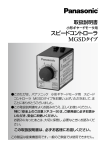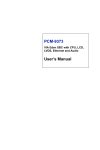Download Advantech PCI-6771 series Specifications
Transcript
PCI-6771 series Socket 370 Pentium® III/Celeron™ Half-size Card PC with High Speed PCI Bus, 3D LCD and Ethernet Copyright Notice This document is copyrighted, 1999. All rights are reserved. The original manufacturer reserves the right to make improvements to the products described in this manual at any time without notice. No part of this manual may be reproduced, copied, translated or transmitted in any form or by any means without the prior written permission of the original manufacturer. Information provided in this manual is intended to be accurate and reliable. However, the original manufacturer assumes no responsibility for its use, nor for any infringements upon the rights of third parties which may result from its use. Acknowledgements Award is a trademark of Award Software International, Inc. IBM, PC/AT, PS/2 and VGA are trademarks of International Business Machines Corporation. Intel and Pentium are trademarks of Intel Corporation. Microsoft Windows® is a registered trademark of Microsoft Corp. UMC is a trademark of United Microelectronics Corporation. All other product names or trademarks are properties of their respective owners. For more information on this and other Advantech products please visit our website at: http://www.advantech.com http://www.advantech.com/epc For technical support and service for please visit our support website at: http://www.advantech.com/support This manual is for the PCI-6771 Series Rev. A1 and B1 Part No. 2006677101 Printed in Taiwan PCI-6771User's Manual 2nd Edition May 2000 1.2 Specifications Standard SBC functions • CPU: Socket 370 for Intel® Pentium III processors up to 650 MHz or higher in the future (Rev. B1 only) and Celeron™ processor up to 500 MHz • BIOS: 2/4 Mbit Flash BIOS, supports Plug & Play, APM 1.2 Support Ethernet Boot ROM Support boot from CD-ROM Support boot from LS-120 ZIP™ Drive Optional Customer icon • Chipset: Intel® 440BX PCI set, FSB 66/100 MHz • 2nd level cache: 256 KB on Pentium III or 128 KB on Celeron™ Processor • System memory: Two SODIMM sockets, support 8 MB to 256 MB, accepts 8/16/32/64/128 MB Synchronous DRAM • PCI IDE interface: One Enhanced IDE interface, supports 2 IDE devices PIO mode 3,4 with bus mastering up to 14 MB/sec. Ultra DMA model up to 33 MB/sec. • Floppy disk drive interface: Supports up to two FDDs (360 KB/1.2 MB/720 KB/1.44 MB/2.88 MB) • Parallel port: One parallel port, supports EPP/ECP • IR port: One 115 kbps IrDA compliant serial infrared • Serial ports: 2 serial ports COM1: RS-232, COM2: RS-232/422/485 • Watchdog timer: 62 levels timer interval, setup by software, jumperless selection, generates system reset or IRQ11 Chapter 1 General Information 3 Contents Chapter 1 General Information ........................................ 1 1.1 1.2 1.3 1.4 Introduction ............................................................................. 2 Specifications .......................................................................... 3 Features ................................................................................... 5 Board layout: Dimensions ...................................................... 6 Chapter 2 Installation ........................................................ 7 2.1 Safety Precautions ...................................................................... 8 2.2 Jumpers ................................................................................... 9 2.3 Connectors ............................................................................ 10 2.3.1 Locating connectors .................................................. 11 2.3.2 Locating Connectors (solder side) ............................. 12 2.4 Locating Jumpers (component side) .................................... 13 2.5 Setting jumpers .................................................................... 14 2.6 CMOS clear function (JP1) ................................................. 15 2.7 Watchdog timer config. (JP2) .............................................. 16 2.8 COM2 settings for RS-232/422/485 (JP3) .............................. 17 2.9 Power type select (JP4) ........................................................ 17 2.10 LCD Panel select (SW1) ...................................................... 18 2.11 Installation Caution ................................................................. 19 2.12 USB Connector (CN1) .......................................................... 20 2.13 Parallel Port Connector (CN2) ............................................ 20 2.14 Hard disk drive LED (CN3) .................................................. 21 2.15 IR Connector (CN4) .............................................................. 21 2.16 ATX power button (CN5) ....................................................... 21 2.17 Keyboard Lock (CN6) ........................................................... 21 2.18 External Speaker (CN7) ....................................................... 22 2.19 Enhanced IDE Connector (CN8) ........................................... 22 2.20 Floppy Drive Connector (CN9) ............................................. 23 2.21 ATX Feature Connector (CN10) .......................................... 23 2.22 Reset switch (CN11) ............................................................. 24 2.23 VGA Display Connector (CN12) .......................................... 24 2.24 CPU Fan Power Supply Connector (CN13) .......................... 24 PCI-6771User's Manual 2.25 2.26 2.27 2.28 2.29 2.30 2.31 2.32 2.33 2.34 2.35 Ethernet Configuration (CN14) ........................................... 25 RS-232 connection (COM1-CN15) ...................................... 25 RS-232/422/485 connection Flat panel Display Connector (CN18) .................................. 26 Ext.flat panel Display Connector(CN19) .............................. 27 Keyboard & PS/2 Mouse Connector (CN20) ....................... 27 External Keyboard (CN21) .................................................... 27 LCD Inverter Connector (CN22) .......................................... 27 AT Power Connector (CN23) ................................................ 28 CompactFlash Disk (CN24) .................................................. 28 Installing System Memory (SODIMMs) .............................. 28 2.35.1 Installing SODIMMs .................................................... 28 2.36 CPU installation and upgrading ........................................... 30 CHAPTER 3 Award Bios Setup ....................................... 31 3.1 AWARD BIOS Setup ................................................................ 32 3.1.1 Entering setup ............................................................... 32 3.1.2 Standard CMOS setup .................................................. 33 3.1.3 BIOS features setup ...................................................... 34 3.1.4 CHIPSET features setup ................................................ 38 3.1.5 Power management setup .............................................. 39 3.1.6 PnP PCI configuration setup ......................................... 40 3.1.7 Load BIOS defaults ....................................................... 40 3.1.8 Load setup defaults ....................................................... 40 3.1.9 Integrated Peripherals ................................................... 41 3.1.10 Password setting ......................................................... 41 3.1.11 IDE HDD auto detection .............................................. 42 3.1.12 Save & exit setup ......................................................... 42 3.1.13 Exit without saving ...................................................... 42 AGP SVGA Setup .............................................................. 43 4.1 4.2 Introduction ........................................................................... 44 4.1.1 Chipset ........................................................................... 44 4.1.2 Display memory .............................................................. 44 4.1.3 Display types ................................................................. 44 4.1.4 Dual/simultaneous display ............................................. 45 Installation of SVGA driver .................................................. 46 Preface and Table of Contents 4.3 4.2.1 Installation for Windows 95/98 ...................................... 47 4.2.2 Installation for Windows NT .......................................... 50 Further information .............................................................. 52 Chapter 5 PCI Bus Ethernet Interface .......................... 53 5.1 5.2 5.3 Introduction ........................................................................... 54 Installation of Ethernet driver .............................................. 54 5.2.1 Installation for MS-DOS and Windows 3.1 .................... 54 5.2.2 Installation for Windows 95/98 ...................................... 55 5.2.3 Installation for Windows NT .......................................... 57 Further information .............................................................. 59 Programming the Watchdog Timer ................................. 61 APPENDIX A Programming the Watchdog Timer ......... 61 A.1 Programming the Watchdog Timer ..................................... 62 Appendix C Pin Assignments ......................................... 65 C.1 C.2 C.3 C.4 C.5 C.6 C.7 C.8 C.9 C.10 C.11 C.12 C.13 C.15 C.16 C.17 C.18 C.19 C.20 C.23 C.22 USB1/USB2 Connector (CN1) ............................................. 66 Parallel Port Connector (CN2) ............................................ 66 HDD LED Connector (CN3) .................................................. 67 IR Connector (CN4) .............................................................. 67 ATX Power Switch (CN5) ..................................................... 67 Keyboard Lock Connector (CN6) ......................................... 68 External Speaker Connector (CN7) ..................................... 68 IDE Hard Drive Connector (CN8) ......................................... 69 Floppy Drive Connector (CN9) ............................................. 69 ATX Power Connector (CN10) ............................................. 70 Reset Switch Connector (CN11) .......................................... 70 CRT Display Connector (CN12) .......................................... 70 CPU Fan Power Connector (CN13) ...................................... 71 COM1 RS-232 Serial Port (CN15) ...................................... 71 COM2 RS-422/485 Serial Port (CN16) .............................. 72 COM2 RS-232 Serial Port (CN17) ...................................... 72 24-bit LCD Display Connector (CN18) ................................ 73 36-bit LCD Display Connector (CN19) ................................ 74 Keyboard and Mouse Connnecto (CN20) .............................. 74 AT Power Connector (CN23) ................................................ 75 LCD Power Inverter (CN22) ................................................ 75 PCI-6771User's Manual C.21 External Keyboard Connector (CN21) ................................. 75 C.24 CompactFlash Card Connector (CN24) ............................... 76 Appendix D System Assignments .................................. 77 D.1 D.2 D.3 D.4 System I/O Ports .................................................................. 78 DMA Channel Assignments ................................................. 79 Interrupt Assignments ......................................................... 79 1st MB Memory Map ............................................................ 80 Tables Table 2-1: Jumpers .......................................................................................... 9 Table 2-2: Connectors .................................................................................... 10 Table 2-3: RTC power and CMOS clear (JP1) ................................................ 15 Table 2-4: Watchdog timer system reset select (JP2) .................................... 16 Table 2-5: COM2 settings for RS-232/422/485 (JP3) .................................... 17 Table 2-6: Power type select (JP4) ................................................................. 17 Table 2-7: Panel Type Select (SW1) .............................................................. 18 Table 2-10: PCI-6771 serial port default settings .......................................... 26 Table C-1: USB1/USB2 connector .................................................................. 66 Table C-2: Parallel port connector .................................................................. 66 Table C-3: HDD LED connector ...................................................................... 67 Table C-4: IR connector .................................................................................. 67 Table C-5:ATX power switch ........................................................................... 67 Table C-6: Keyboard lock connector .............................................................. 68 Table C-7: External speaker connector ........................................................... 68 Table C-8: IDE hard drive connector .............................................................. 69 Table C-9: Floppy drive connector ................................................................. 69 Table C-10: ATX power connector .................................................................. 70 Table C-11: Reset switch connector .............................................................. 70 Table C-12: CRT display connector ................................................................ 70 Table C-13: CPU fan power connector ........................................................... 71 Preface and Table of Contents Table C-15: COM1 RS-232 serial port ............................................................. 71 Table C-16: COM2 RS-232/422/485 serial port ............................................. 72 Table C-17: COM2 RS-232 serial port ............................................................. 72 Table C-5: 24-bit LCD display connector ....................................................... 73 Table C-19: 36-bit LCD display connector ..................................................... 74 Table C-20: Keyboard and mouse connector ................................................. 74 Table C-23: AT power connector .................................................................... 75 Table C-22: LCD power inverter ...................................................................... 75 Table C-21: External keyboard connector ...................................................... 75 Table C-24: CompactFlash card connector .................................................... 76 Table D-1: System I/O ports ........................................................................... 78 Table D-2: DMA channel assignments ........................................................... 79 Table D-3: Interrupt assignments .................................................................. 79 Table D-4:1st MB memory map ...................................................................... 80 Figures Figure 1-1: PCA-6771 board layout Dimensions ............................................. 5 Figure 2-1: Locating connectors (component side) ...................................... 11 Figure 2-2: Locating connectors (solder side) .............................................. 12 Figure 2-3: Locating jumpers (component side) ........................................... 13 Figure 2-4: ATX adaptor cable ........................................................................ 23 Figure 2-5: SODIMM dimensions ................................................................... 29 Figure 3-1: Setup program initial screen ....................................................... 32 Figure 3-2: CMOS setup screen ..................................................................... 33 Figure 3-3: BIOS features setup screen ......................................................... 34 Figure 3-4: CHIPSET features setup screen .................................................. 38 Figure 3-5: Power management setup screen .............................................. 39 Figure 3-6: PCI configuration screen ............................................................ 40 Figure 3-7: Integrated peripherals ................................................................ 41 Figure 3-8: Exiting ......................................................................................... 42 PCI-6771User's Manual Preface and Table of Contents CHAPTER 1 General Information This chapter gives background information on the PCI-6771. Sections include: • Introduction • Features • Specifications • Board layout and dimensions 1.1 Introduction The PCI-6771 all-in-one industrial grade PCI-bus CPU card uses Intel’s highly acclaimed Celeron® processor or Pentium® III processor, together with the Intel 440BX PCI chipset. The CPU provides 128 KB (or 256 KB for Pentium III) on-CPU L2 cache, eliminating the need for external SRAM chips. It has one PCI EIDE interface for up to two devices and a floppy disk drive interface for up to two devices. Other features include two RS-232 serial ports (16C550 UARTs with 16-byte FIFO or compatible), one enhanced parallel port (supports SPP/EPP/ECP) and one USB (Universal Serial Bus) port. The PCI enhanced IDE controller supports Ultra DMA/33 and PIO Mode 4 operation. This provides data transfer rates of over 33 MB/sec. System Bios supports boot-up from an IDE CD-ROM, SCSI CD-ROM and LS120. A backup of CMOS data is stored in the Flash memory, which protects data even after a battery failure. Also included is a 62level Watchdog timer which resets the CPU or generates an interrupt if a program cannot be executed normally. This enables reliable operation in unattended environments. The PCI-6771 offers several impressive industrial features such as VGA (AGP) controller, two SODIMM slots for a total of 256 MB RAM memory and a 10/100Base-T networking controller. In addition, the PCI-6771 series supports a solid state disk (SSD) using a CompactFlash™ disk that is not as vulnerable to the hazards of an industrial computing environment. These features make it an ideal choice for applications that require both high performance and full functionality. 2 PCI-6771 User's Manual 1.2 Specifications Standard SBC functions • CPU: Socket 370 for Intel® Pentium III processors up to 650 MHz or higher in the future (Rev. B1 only) and Celeron™ processor up to 500 MHz • BIOS: 2/4 Mbit Flash BIOS, supports Plug & Play, APM 1.2 Support Ethernet Boot ROM Support boot from CD-ROM Support boot from LS-120 ZIP™ Drive Optional Customer icon • Chipset: Intel® 440BX PCI set, FSB 66/100 MHz • 2nd level cache: 256 KB on Pentium III or 128 KB on Celeron™ Processor • System memory: Two SODIMM sockets, support 8 MB to 256 MB, accepts 8/16/32/64/128 MB Synchronous DRAM • PCI IDE interface: One Enhanced IDE interface, supports 2 IDE devices PIO mode 3,4 with bus mastering up to 14 MB/sec. Ultra DMA model up to 33 MB/sec. • Floppy disk drive interface: Supports up to two FDDs (360 • IR port: One 115 kbps IrDA compliant serial infrared • Serial ports: 2 serial ports COM1: RS-232, COM2: RS-232/422/485 • Watchdog timer: 62 levels timer interval, setup by software, jumperless selection, generates system reset or IRQ11 Chapter 1 General Information 3 • Parallel port: One parallel port, supports EPP/ECP VGA function AGP SVGA/Flat Panel Interface • Chipset: Trident™ Cyber 9525 DVD, high performance 64-bit GUI, 3D engine • Display memory: 2.5 MB of SDRAM frame buffer on cyber 9525DVD. (with optional 8 MB) • Display type: Simultaneously supports CRT and flat panel (EL, LCD and gas plasma) displays • Interface: 2x AGP, Accelerator Graphics Ports 1.0 compliant • Display mode: LCD panel supports up to 800 x 600 @ 24 bpp, 1024 x 768 @ 24 bpp. CRT display supports up to 800 x 600 @ 24 bpp, 1024 x 768 @ 24 bpp Ethernet controller functions • RealTek™ RTL 8139 chip PCI Ethernet controller, IEEE 802.3 protocol compatible Supports 10/100 Mbps Base-T Solid state disk • Supports CompactFlash™ disks 4 PCI-6771 User's Manual Mechanical and environmental specifications • Standard Mode Power Consumption 4.73 A @ 5 V with Celeron™ 466, 128 MB SO DIMM • Operating temperature: 0 ~ 60° C (32 ~ 140° F) • Size: 185 mm x 122 mm • Weight: 0.26 kg 1.3 Features • Supports Socket 370 for Intel® Pentium® III/Celeron™ processor • AGP 3D VGA/LCD and supports 36 bit XGA TFT LCD Panel • USB interface compliant with USB rev. 1.0 • SIR support • System overheat temperature control • 62-levels Watchdog timer, jumperless on-line setup supported • Supports wake-up on LAN, Modem • Supports turn off LCD back light function • Supports PCI interface compliant with PCI rev. 2.1 • Supports four PCI Bus masters Chapter 1 General Information 5 1.4 Board layout: Dimensions Figure 1-1: PCI-6771 (dimensions) 6 PCI-6771 User's Manual CHAPTER 2 Installation This chapter tells how to set up the PCI-6771 hardware. It includes instructions on setting jumpers, and connecting peripherals, switches and indicators. Be sure to read all the safety precautions before you begin the installation procedure. 2.1 Safety Precautions Follow these simple precautions to protect yourself from harm and your PC from damage. 1. To avoid electric shock, always disconnect the power from your PC chassis before you work on it. Don't touch any components on the CPU card or other cards while the PC is on. 2. Disconnect power before making any configuration changes. The sudden rush of power as you connect a jumper or install a card may damage sensitive electronic components. 3. Always ground yourself to remove any static charge before you touch your CPU card. Be particularly careful not to touch the chip connectors. Modern integrated electronic devices, especially CPUs and memory chips, are extremely sensitive to static electric discharges and fields. Keep the card in its antistatic packaging when it is not installed in the PC, and place it on a static dissipative mat when you are working with it. Wear a grounding wrist strap for continuous protection. 2.2 Jumpers The PCI-6771 has a number of jumpers that allow you to configure your system to suit your application. The table below lists the function of each of the board’s jumpers. Table Label JP1 2-1: Jumpers Function CMOS clear JP2 Watchdog timer action JP3 COM2 RS-232/422/485 setting JP4 Power type select SW1 Panel type select Chapter 2 Installation 9 2.3 Connectors On-board connectors link the PCI-6771 to external devices such as hard disk drives, a keyboard, or floppy drives. The table below lists the function of each of the board’s connectors. 10 Table 2-2: Label Function C onnectors CN1 USB channel 1, 2 connector CN2 Parallel port connector CN3 External IDE LED CN4 IR connector CN5 ATX power switch button CN6 Keyboard Lock connector CN7 Speaker connector CN8 IDE hard drive connector CN9 Floppy drive connector CN10 ATX feature connector CN11 Reset connector CN12 CRT display connector CN13 Fan power connector CN14 Ethernet 100/10Base-T connector CN15 COM1, 232 connector CN16 COM2, 422/485 connector CN17 COM2, 232 connector CN18 Flat panel connector CN19 Ext. flat panel display connector CN20 Keyboard and PS/2 mouse connector CN21 EXT keyboard connector CN22 LCD inverter power CN23 Main power connector CN24 CFC connector PCI-6771 User's Manual 2.3.1 Locating connectors Figure 2-1: Locating connectors (component side) Chapter 2 Installation 11 2.3.2 Locating Connectors (solder side) Figure 2-2: Locating connectors (solder side) 12 PCI-6771 User's Manual 2.4 Locating Jumpers (component side) Figure 2-3: Locating jumpers (component side) Chapter 2 Installation 13 2.5 Setting jumpers You configure your card to match the needs of your application by setting jumpers. A jumper is the simplest kind of electric switch. It consists of two metal pins and a small metal clip (often protected by a plastic cover) that slides over the pins to connect them. To “close” a jumper, connect the pins with the clip. To “open” a jumper, remove the clip. Sometimes a jumper will have three pins, labeled 1, 2, and 3. In this case, you would connect either pins 1 and 2 or 2 and 3. 1 Open Closed 2 3 Closed 2-3 The jumper settings are schematically depicted in this manual as follows: 1 Open Closed Closed 2-3 A pair of needle-nose pliers may be helpful when working with jumpers. Setting switches is slightly different but more simple. Simply slide the desired switch to the on or off position. In the example below, the 6 element switch would be. 1:off, 2:on, 3:off, 4:off, 5:off, 6:off. On Off 1 2 3 4 5 6 If you have any doubts about the best hardware configuration for your application, contact your local distributor or sales rep 14 PCI-6771 User's Manual 2.6 CMOS clear function (JP1) Warning: Table 2-3: To avoid damaging the computer, always turn off the power supply before setting "Clear CMOS". Set the jumper back to normal before turning on the power supply. RTC power and *Normal 1 CMOS clear (JP1) CMOS data clear 1 JP1 * default setting Chapter 2 Installation 15 2.7 Watchdog timer config. (JP2) An on-board watchdog timer reduces the chance of disruptions which EMP (electro-magnetic pulse) interference can cause. This is an invaluable protective device for standalone or unmanned applications. Setup involves two jumpers and running the control software. (Refer to Appendix A.) When the watchdog timer is enabled and the CPU shuts down, the watchdog timer will automatically either reset the system or generate an interrupt on IRQ 11, depending on the setting of jumper JP2, as shown below: Table 2-4: Watc hdog timer sys tem *System Reset 1 JP2 * default setting 16 PCI-6771 User's Manual reset select (JP2) IRQ 11 interrupt 1 2.8 COM2 settings for RS-232/422/485 (JP3) Table 2-5: COM2 settings for RS-232/422/485 *RS-232 JP3 (JP3) RS-422 RS-485 1 2 1 2 1 2 3 4 3 4 3 4 5 6 5 6 5 6 * default setting 2.9 Power type select (JP4) Table 2-6: Po wer t ype select ATX Power 1 (JP4) *AT Power 1 JP4 * default setting Chapter 2 Installation 17 2.10 LCD Panel select (SW1) Table 2-7: P anel T ype Select Display (S W1) TYPE Setting (SW1) On 640 x 480 18 bits TFT Off 1 2 3 4 5 6 800 x 600 18 bits TFT On Off 1 2 3 4 5 6 1024 x 768 24 bits TFT On Off 1 2 3 4 5 6 On 1024 x 768 36 bits TFT Off 1 2 3 4 5 6 On 640 x 480 16 bits STN Off 1 2 3 4 5 6 On 800 x 600 16 bits STN Off 1 2 3 4 5 6 On 1024 x 768 16 bits STN Off 1 2 3 4 5 6 1024 x 768 24 bits STN On Off 1 2 3 4 5 6 * Please Note: Pin 6 is extra, please disregard! 18 PCI-6771 User's Manual 2.11 Installation Caution The following sections tell how to make each connection. In most cases, you will simply need to connect a standard cable. All of the connector pin assignments are shown in Appendix C. Warning! Always completely disconnect the power cord from your chassis whenever you are working on it. Do not make connections while the power is on. Sensitive electronic components can be damaged by a sudden rush of power. Only experienced electronics personnel should open the PC chassis. Caution! Always ground yourself to remove any static charge before touching the CPU card. Modern electronic devices are very sensitive to static electric charges. Use a grounding wrist strap at all times. Place all electronic components on a static-dissipative surface or in a static-shielded bag when they are not in the chassis. Chapter 2 Installation 19 2.12 USB Connector (CN1) The PCI-6771 board provides two USB (Universal Serial Bus) interfaces, which give complete plug and play and also hot attach/detach for up to 127 external devices. The USB interfaces comply with USB specification rev. 1.0 and are fuse protected. The USB interfaces are accessed through a 10-pin flat-cable connector, CN1. The adapter cable has a 10-pin connector on one end and a USB connector on the bracket. The USB interfaces can be disabled in the system BIOS setup. 2.13 Parallel Port Connector (CN2) The parallel port is normally used to connect the CPU card to a printer. The PCI-6771 includes an on-board parallel port, accessed through a 26-pin flat-cable connector, CN2. The card comes with an adapter cable which lets you use a traditional DB-25 connector. The cable has a 26-pin connector on one end and a DB-25 connector on the other, mounted on a retaining bracket. The bracket installs at the end of an empty slot in your chassis, giving you access to the connector. The parallel port is designated as LPT1, and can be disabled or changed to LPT2 or LPT3 in the system BIOS setup. To install the bracket, find an empty slot in your chassis. Unscrew the plate that covers the end of the slot. Screw in the bracket in place of the plate. Next, attach the flat-cable connector to CN2 on the CPU card. Wire 1 of the cable is red or blue, and the other wires are gray. Make sure that wire 1 corresponds to pin 1 of CN2. Pin 1 is on the right side of CN2. 20 PCI-6771 User's Manual 2.14 Hard disk drive LED (CN3) You can connect an LED to connector CN3 to indicate when the HDD is active. Marks on the circuit board indicate LED polarity. 2.15 IR Connector (CN4) This connector supports the optional wireless infrared transmitting and receiving module. This module mounts on the system case. You must configure the setting through BIOS setup. 2.16 ATX power button (CN5) The PCI-6771 provides an ATX power input connector. When connected with the ATX power switch, the ATX power switch connector (CN5) enables power On/Off from the chassis. 2.17 Keyboard Lock (CN6) Connecting CN6 enables the keyboard locking function from the front panel of your chassis. Chapter 2 Installation 21 2.18 External Speaker (CN7) Connect external speakers to CN7. To activate the on-board buzzer, set the connector so that Pins 3 and 4 are closed. 2.19 Enhanced IDE Connector (CN8) You can attach two IDE (Integrated Device Electronics) drives to the PCI-6771’s internal controller. The PCI-6771 CPU card has an EIDE connector, CN8. Wire number 1 on the cable is red or blue, and the other wires are gray. Connect one end to connector CN8 on the CPU card. Make sure that the red (or blue) wire corresponds to pin 1 on the connector (on the right side). See Chapter 1 for help in finding the connector. Unlike floppy drives, IDE hard drives can connect in either position on the cable. If you install two drives, you will need to set one as the master and one as the slave. You do this by setting the jumpers on the drives. If you use just one drive, you should set it as the master. See the documentation that came with your drive for more information. Connect the first hard drive to the other end of the cable. Wire 1 on the cable should also connect to pin 1 on the hard drive connector, which is labeled on the drive circuit board. Check the documentation that came with the drive for more information. Connect the second drive, as described above, on CN8. 22 PCI-6771 User's Manual 2.20 Floppy Drive Connector (CN9) You can attach up to two floppy disk drives to the PCI-6771’s onboard controller. You can use any combination of 5.25" (360 KB/ 1.2 MB) and/or 3.5" (720 KB/1.44/2.88 MB) drives. The card comes with a 34-pin daisy-chain drive connector cable. On one end of the cable is a 34-pin flat-cable connector. On the other end are two sets of floppy disk drive connectors. Each set consists of a 34-pin flat-cable connector (usually used for 3.5" drives) and a printed-circuit-board connector (usually used for 5.25" drives). You can use only one connector in each set. The set on the end (after the twist in the cable) connects to the A: floppy. The set in the middle connects to the B: floppy. 2.21 ATX Feature Connector (CN10) When the PCI-6771 is used as a stand alone card, both the 4-pin main power connector (CN23) and the ATX feature connector (CN10) must be connected to the power supply. If the PCI-6771 is used with a passive backplane, the main power connector (CN23) should not be connected as the card will be powered from the backplane. ATX power supply source To ATX feature connector (CN10) (P8) 6-pin in backplane P8 • • P9 (P9) 6-pin in backplane • • • 20-pin female connector Figure 2-4: ATX Adaptor cable The ATX adapter cable (provided) is used to connect the PCI6771 to the ATX power supply. The ATX adapter cable has Chapter 2 Installation 23 different connectors at both ends. On one end is the ATX 20-pin (female type) which connects to the (male) ATX power supply source. The other end has a 3-pin connector (female type) which connects to the ATX feature connector (CN10) on the board itself. This end also has the 6-pin main power connector (P8) and a 6pin connector (P9) which is used when the board is mounted on a passive backplane. 2.22 Reset switch (CN11) If you install a reset switch, it should be a single pole switch rated at 10 mA, 5 V. Momentarily pressing the switch will activate a reset. For reset switch pin assignments, please see Appendix C. 2.23 VGA Display Connector (CN12) The PCI-6771 provides a VGA controller for a high resolution VGA interface. The PCI-6771 CN12 is a DB-15 connector for VGA monitor input. Pin assignments for the CRT display are detailed in Appendix C. 2.24 CPU Fan Power Supply Connector (CN13) This provides power supply to the optional CPU cooling fan. This connector is only available when +12 V power is supplied to the board. Warning! Before making the connection, make sure the voltage is absolutely correct and matched with the correct connector. 24 PCI-6771 User's Manual 2.25 Ethernet Configuration (CN14) The PCI-6771 is equipped with a high performance 32-bit PCI-bus Fast Ethernet interface which is fully compliant with IEEE 802.3u 10/100Base-T specifications. It is supported by all major network operating systems. The medium type can be configured via the RSET8139.EXE program included on the utility disk. (See Chapter 5 for detailed information.) RJ-45A connector (CN14) 10/100Base-T connects to the PCI-6771 via an adapter cable to the RJ-45 standard jack. Network boot The network boot feature is built into the BIOS. It can be enabled or disabled in the chipset setup of the CMOS configuration. Refer to "BIOS Setting" in Chapter 3 for more information. 2.26 RS-232 connection (COM1-CN15) Different devices implement the RS-232 standard in different ways. If you are having problems with a serial device, be sure to check the pin assignments for the connector. Chapter 2 Installation 25 2.27 RS-232/422/485 connection (COM2-CN17: RS-232; CN16: RS-422/485) COM2 is an RS-232/422/485 serial port. The specific port type is determined by jumper settings (JP3), as detailed in Chapter 1. The IRQ and address range for both ports are fixed. However, if you wish to disable the port or change these parameters later, you can do this in the system BIOS setup. The table below shows the settings for the PCI-6771 board's ports: Table 2-10: PCI-6771 serial port def ault settings Port Address Interrupt Default COM1 3F8, 3E8 IRQ4 3F8 COM2 2F8, 2E8 IRQ3 2F8 2.28 Flat panel Display Connector (CN18) CN18 is a 40-pin connector which can support a 24-bit TFT LCD. It is Hirose’s product no. DF13A-40DP-1.25V. The PCI-6771 provides a bias control signal on CN18 that can be used to control the LCD bias voltage. It is recommended that the LCD bias voltage not be applied to the panel until the logic supply voltage (+5 V or +3.3 V) and panel video signals are stable. Under normal operation, the control signal (ENAVEE) is active high. When the PCI-6771’s power is applied, the control signal is low until just after the relevant flat panel signals are present. 26 PCI-6771 User's Manual 2.29Ext.flat panel Display Connector(CN19) CN19 consists of a 20-pin header, which is Hirose’s product no. DF13A-20DP-1.25V. The PCI-6771 supports a 36-bit LCD panel with connections to both CN18 and CN19. For details of pin assignments, refer to Appendix C. 2.30 Keyboard & PS/2 Mouse Connector (CN20) The PCI-6771 board provides a keyboard connector. A 6-pin mini-DIN connector (CN20) on the card mounting bracket supports single-board computer applications. The card comes with an adapter to convert from the 6-pin mini-DIN connector to a standard DIN connector and to a PS/2 mouse connector. 2.31 External Keyboard (CN21) In addition to the PS/2 mouse/keyboard connector, an additional external keyboard connector is provided. For external keyboard pin assignments, please see Appendix C. 2.32 LCD Inverter Connector (CN22) The LCD inverter is connectoed to CN22 via a 5-pin connector to provide +12 V power to the LCD display. The pin assignments for CN22 can be found in Appendix C. Chapter 2 Installation 27 2.33 AT Power Connector (CN23) If you prefer not to acquire power through PCI-6771’s backplane via the gold H-connectors, CN23 also provides power input connectors for +5 V and +12 V. (see Appendix C) 2.34 CompactFlash Disk (CN24) The PCI-6771 is equipped with a CompactFlash™ disk socket on the solder side that supports the IDE interface for CompactFlash cards. The on-board CompactFlash socket is designed to prevent incorrect installation. Be sure that the system power is off when installing and removing CompactFlash™ cards. The CompactFlash card is defaulted as the Secondary channel slave drive on your PC system. 2.35 Installing System Memory (SODIMMs) You can install anywhere from 8 to 256 MB of SDRAM into your PCI-6771 series card. The card provides two 144-pin SODIMM sockets. Each socket accepts 8, 16, 32, 64 or 128 MB 3.3 V power level SODIMMs. If only one SODIMM module is installed, it may be installed in either SODIMM socket on the solder side of the PCI-6771 series card. Note: PCI-6771 card only supports SDRAM SODIMM modules. EDO SODIMM is not supported. 2.35.1 Installing SODIMMs Note 1:The modules can only fit into a socket one way. Their gold pins must point down into the SODIMM socket. Please refer to the diagram below for dimensions. 28 PCI-6771 User's Manual The procedure for installing SODIMMs appears below. Please follow these steps carefully. 1. Ensure that all power supplies to the system are switched Off. 2. Install the SODIMM card. Install the SODIMM so that its gold pins point down into the SODIMM socket. 3. Slip the SODIMM into the socket at a 45 degree angle and carefully fit the bottom of the card against the connectors. 4. Gently push the SODIMM into a perpendicular position until the clips on the ends of the SODIMM sockets snap into place. 5. Check to ensure that the SODIMM is correctly seated and all connector contacts touch. The SODIMM should not move around in its socket. Figure 2-5: Standard SODIMM Dimensions Note 2:Only use Standard Form SODIMM memory modules (As shown in the dimensions above). Standardized dimensions ensure a proper fit. Check with your Memory supplier about the SODIMM modules you will use. Chapter 2 Installation 29 2.36 CPU installation and upgrading 1. If you are upgrading the CPU, remove the old CPU from the socket. If it is difficult to remove, you may find chip lubricant (designed for pin-grid-array devices, PGAs) and a chip puller helpful. Both are available at electronics hobby supply stores. 2. Plug the new CPU into the empty socket. Follow the instructions that came with the CPU or math coprocessor. If you have no instructions, do the following: Lubricate the CPU pins with lubricant made for PGA devices. This will make the new CPU slide in much more easily, and reduce the chance of damaging it. Next, carefully align the CPU so that it is parallel to the socket and the notch on the corner of the CPU corresponds with the notch on the inside of the socket. Gently slide the CPU in. There will probably be a gap between the CPU and the connector when it is fully seated - do not push too hard! 30 PCI-6771 User's Manual CHAPTER 3 Award BIOS Setup This chapter describes how to set the card’s BIOS configuration data. 3.1 AWARD BIOS Setup Figure 3-1: Setup program initial screen Award’s BIOS ROM has a built-in Setup program that allows users to modify the basic system configuration. This type of information is stored in battery-backed RAM so that it retains the Setup information when the power is turned off. 3.1.1 Entering setup Turning on the computer and pressing <DEL> immediately will allow you to enter Setup. 32 PCI-6771 User's Manual 3.1.2 Standard CMOS setup Choose the “STANDARD CMOS SETUP” option from the INITIAL SETUP SCREEN Menu, and the screen below is displayed. This standard Setup Menu allows users to configure system components such as date, time, hard disk drive, floppy drive, display, and memory. Figure 3-2: CMOS setup screen Chapter 3 Award BIOS Setup 33 3.1.3 BIOS features setup The “BIOS FEATURES SETUP” screen appears when choosing the BIOS FEATURES SETUP item from the CMOS SETUP UTILITY Menu. It allows the user to configure the PCA-6770 according to his particular requirements. Below are some major items that are provided in the BIOS FEATURES SETUP screen: Figure 3-3: BIOS features setup screen Virus Warning During and after the system boots up, any attempt to write to the boot sector or partition table of the hard disk drive will halt the system. In this case, a warning message will be displayed. You can run the antivirus program to locate the problem. If Virus Warning is Disabled, no warning message will appear if anything attempts to access the boot sector or hard disk partition. CPU Internal Cache/External Cache Depending on the CPU/chipset design, these options can speed up memory access when enabled. 34 PCI-6771 User's Manual Quick Power On Self Test This option speeds up the Power-On Self Test (POST) conducted as soon as the computer is turned on. When enabled, BIOS shortens or skips some of the items during the test. When disabled, normal POST procedures assumes. Boot Sequence This function determines the sequence in which the computer will search the drives for the disk operating system (i.e. DOS). The default value is “C, A”. A,C System will first search the FDD, then the HDD. C,A System will first search the HDD, then the FDD. C only System will only search the HDD. • • • • • • Boot Up Floppy Seek During POST, BIOS will determine if the floppy disk drive installed is 40 or 80 tracks. 360 KB type is 40 tracks while 720 KB, 1.2 MB, and 1.44 MB are all 80 tracks. Enabled BIOS searches the floppy drive to determine if it is 40 or 80 tracks. Note that BIOS cannot differentiate 720 KB, 1.2 MB, and 1.44 MB type drives as they are all 80 tracks. Disabled BIOS will not search for the floppy drive type by track number. Note that there will not be any warning message if the drive installed is 360 KB. Boot Up NumLock Status The default is “On”. On Keypad boots up to number keys. Off Keypad boots up to arrow keys. Chapter 3 Award BIOS Setup 35 Boot Up System Speed High Sets the speed to high Low Sets the speed to low IDE HDD Block Mode Enabled Enable IDE HDD Block Mode. BIOS will detect the block size of the HDD and send a block command automatically. Disabled Disable IDE HDD Block Mode Gate A20 option Normal The A20 signal is controlled by the keyboard controller or chipset hardware Fast Default: Fast. The A20 signal is controlled by Port 92 or chipset specific method. Typematic Rate Setting The typematic rate determines the characters per second accepted by the computer. Typematic Rate setting enables or disables the typematic rate. Typematic Rate (Char/Sec) BIOS accepts the following input values (character/second) for Typematic Rate: 6, 8, 10, 12, 15, 20, 24, 30. Typematic Delay (msec) When holding down a key, the Typematic Delay is the time interval between the appearance of the first and second characters. The input values (msec) for this category are: 250, 500, 750, 1000. Security Option This setting determines whether the system will boot if the password is denied, while limiting access to Setup. 36 PCI-6771 User's Manual System The system will not boot, and access to Setup will be denied if the correct password is not entered at the prompt. Setup The system will boot, but access to Setup will be denied if the correct password is not entered at the prompt. Note: To disable security, select PASSWORD SETTING in the main menu. At this point, you will be asked to enter a password. Simply hit the <ENTER> key to disable security. When security is disabled, the system will boot, and you can enter Setup freely. OS Select for DRAM>64 MB This setting is under OS/2 system. Video BIOS Shadow This determines whether video BIOS will be copied to RAM, which is optional according to the chipset design. When enabled, Video Shadow increases the video speed. C8000 - CFFFF Shadow/DC000-DFFFF Shadow These determine whether optional ROM will be copied to RAM in blocks of 16 KB. Enabled Optional shadow is enabled Disabled Optional shadow is disabled Chapter 3 Award BIOS Setup 37 3.1.4 CHIPSET features setup By choosing the “CHIPSET FEATURES SETUP” option from the INITIAL SETUP SCREEN Menu, the screen below is displayed. This sample screen contains the manufacturer’s default values for the PCA-6770. Figure 3-4: CHIPSET features setup screen 38 PCI-6771 User's Manual 3.1.5 Power management setup The power management setup controls the CPU cards’ “green” features. The following screen shows the manufacturer’s default. Figure 3-5: Power management setup screen Power Management This option allows you to determine if the values in power management are disabled, user-defined, or predefined. HDD Power Management You can choose to turn the HDD off after a one of the time interval listed, or when the system is in Suspend mode. If in a power saving mode, any access to the HDD will wake it up. Note: HDD will not power down if the Power Management option is disabled. IRQ Activity IRQ can be set independently. Activity on any enabled IRQ will wake up the system. Chapter 3 Award BIOS Setup 39 3.1.6 PnP PCI configuration setup Figure 3-6: PCI configuration screen 3.1.7 Load BIOS defaults “LOAD BIOS DEFAULTS” indicates the most appropriate values for the system parameters for minimum performance. These default values are loaded automatically if the stored record created by the Setup program becomes corrupted (and therefore unusable). 3.1.8 Load setup defaults “LOAD SETUP DEFAULTS” loads the values required by the system for maximum performance. 40 PCI-6771 User's Manual 3.1.9 Integrated Peripherals Figure 3-7: Integrated peripherals Note: If you enable the IDE HDD block mode, the enhanced IDE driver will be enabled. 3.1.10 Password setting To change, confirm, or disable the password, choose the “PASSWORD SETTING” option form the Setup main menu and press [Enter]. The password can be at most 8 characters long. Remember, to enable this feature. You must first select the Security Option in the BIOS FEATURES SETUP to be either “Setup” or “System.” Pressing [Enter] again without typing any characters can disable the password setting function. Chapter 3 Award BIOS Setup 41 3.1.11 IDE HDD auto detection “IDE HDD AUTO DETECTION” automatically self-detect for the correct hard disk type. 3.1.12 Save & exit setup If you select this and press the [Enter] key, the values entered in the setup utilities will be recorded in the CMOS memory of the chipset. The microprocessor will check this every time you turn your system on and compare this to what it finds as it checks the system. This record is required for the system to operate. Figure 3-8: Exiting 3.1.13 Exit without saving Selecting this option and pressing the [Enter] key lets you exit the Setup program without recording any new values or changing old ones. 42 PCI-6771 User's Manual CHAPTER AGP SVGA Setup • Introduction • Installation of SVGA driver for - Windows 95 - Windows 98 - Windows NT 4 4.1 Introduction The PCI-6771 has an on-board AGP flat panel/VGA interface. The specifications and features are described as follows: 4.1.1 Chipset The PCI-6771 uses a Trident 9525DVD chipset for its AGP/SVGA controller. It supports many popular LCD, EL, and gas plasma flat panel displays and conventional analog CRT monitors. The 9525 VGA BIOS supports monochrome LCD, EL, color TFT and STN LCD flat panel displays. In addition, it also supports interlaced and non-interlaced analog monitors (color and monochrome VGA) in high-resolution modes while maintaining complete IBM VGA compatibility. Digital monitors (i.e. MDA, CGA, and EGA) are NOT supported. Multiple frequency (multisync) monitors are handled as if they were analog monitors. 4.1.2 Display memory With 2.5 MB display memory on chip, the VGA controller can drive CRT displays or color panel displays with resolutions up to 1024 x 768 at 16.8 M colors. (With an option of 8 MB display memory on chip). This yields true-color resolution of 1280 x 1024. 4.1.3 Display types CRT and panel displays can be used simultaneously. The PCI-6771 can be set in one of three configurations: on a CRT, on a flat panel display, or on both simultaneously. The system is initially set to simultaneous display mode. The BIOS setup can be used to configure the display. In BIOS, select “Integrated Peripherals”, then “Boot-up display type.” You can then choose one of the following modes: “CRT only”, “Panel only”, or “Simultaneous.” 44 PCI-6771 User's Manual 4.1.4 Dual/simultaneous display The PCI-6771 uses a Trident Cyber 9525DVD LCD controller that is capable of providing multiple views and simultaneous display with mixed video and graphics on a flat panel and CRT. To set up dual display under Windows 98, follow these steps: 1. Select “Windows98”, “Control panel”, “Display”, “Settings”. 2. Select “1” for current display, or “2” for second display. 3. Enable “Extend my Windows desktop onto this monitor”. 4. Click “OK”. Figure 4-1: Selecting display settings Chapter 4 AGP SVGA Setup 45 4.2 Installation of SVGA driver Complete the following steps to install the SVGA driver. Follow the procedures in the flow chart that apply to the operating system that you are using within your PCI-6771. Important: The following windows illustrations are examples only. You must follow the flow chart instructions and pay attention to the instructions which then appear on your screen. Note: 46 <Enter> means pressing the “Enter” key on the keyboard. PCI-6771 User's Manual 4.2.1 Installation for Windows 95/98 1. a. Select "Start" , "Settings" , "Control Panel" , "Display" , "Settings". b. Press "Advanced Properties". 2. a. Choose the "Adapter" label. b. Press the "Change..." button. 3. a. Select the second item. 4. a. Press the "Have Disk" button. Chapter 4 AGP SVGA Setup 47 5. a . In sert th e d isc in to the C D -R O M d rive . b . Typ e "D :\slo tpc\67 71 \ V G A .1 00 \W in 9 X ". c. P ress "O K ". 6. a . Fo r W ind o w s 98 , select "Tride nt C yb er 95 2 5D V D P C I/A G P (W 9 8.23 )". Fo r W ind o w s 95 , select "Tride nt C yb er 95 2 5 D V D P C I/A G P (9 5m V )". b . C lick th e "O K " b utto n. 7. a . C lick th e "N e xt" b utto n. 8. a . "Tride n t C yb er9 5 25 D V D P C I/A G P " a pp e ars in the A da p ter. b . C lick th e "A p ply" b utto n. 48 PCI-6771 User's Manual D:\slotpc\6771\VGA.100\Win9X 9. a. P re s s "Ye s " to re b o o t. 10. a . R e p e a t S te p 1 o n th e p re v io u s p a g e o f th is m a n u a l. The "Trident" lab el a p p e a rs in "D is p la y ". b . A d ju s t re s o lu tio n a n d c o lo r. 11. a. Click "Advanced" for further adjustment. b. Click "OK" to exit. END Chapter 4 AGP SVGA Setup 49 4.2.2 Installation for Windows NT 1. a. Select "Start", "Settings", "Control Panel". b. Double click the "Display" icon. 2. a. Choose the "Settings" label. b. Press the "Display Type" button. 3. a. Press the "Change..." button. 4. a. Click the "Have Disk..." button. 50 PCI-6771 User's Manual 5. a . In s ert th e d isc in to the C D -R O M d riv e . b . Typ e "D :\slo tpc \67 71 \ V G A .1 00 \W in 9 X ". c . P res s "O K ". 6. a . F o r W ind o w s 98 , s elec t "Tride nt C y b er 95 2 5D V D P C I/A G P (W 9 8.23 )". F o r W ind o w s 95 , s elec t "Tride nt C y b er 95 2 5 D V D P C I/A G P (9 5m V )". b . C lic k th e "O K " b utto n. 7. a . C lic k th e "N e xt" b utto n. 8. a . "Tride n t C y b er9 5 25 D V D P C I/A G P " a pp e ars in the A da p ter. b . C lic k th e "A p ply" b utto n. D:\slotpc\6771\VGA.100\Win9X Chapter 4 AGP SVGA Setup 51 9. a. Repeat Step 1 in this manual, to select the "Settings" label. b. Adjust resolution and color. c. Click "Test" to see the result. d. Click "OK" to save the setting. END 4.3 Further information For further information about the AGP/SVGA installation in your PCI-6771, including driver updates, troubleshooting guides and FAQ lists, visit the following web resources: Trident website: www.trid.com Advantech websites: www.advantech.com www.advantech.com.tw 52 PCI-6771 User's Manual CHAPTER 5 PCI Bus Ethernet Interface This chapter provides information on Ethernet configuration. • Introduction • Installation of Ethernet driver for Windows 95/98/NT • Further information 5.1 Introduction The PCI-6771 is equipped with a high performance 32-bit Ethernet chipset which is fully compliant with IEEE 802.3 100 Mbps CSMA/ CD standards. It is supported by major network operating systems. It is also both 100Base-T and 10Base-T compatible. The medium type can be configured via the RSET8139.exe program included on the utility disk. The Ethernet port provides a standard RJ-45 jack on board. The network boot feature can be utilized by incorporating the boot ROM image files for the appropriate network operating system. The boot ROM BIOS files are combined with system BIOS, which can be enabled/disabled in the BIOS setup. 5.2 Installation of Ethernet driver Before installing the Ethernet driver, note the procedures below. You must know which operating system you are using in your PCI-6771, and then refer to the corresponding installation flow chart. Then just follow the steps described in the flow chart. You will quickly and successfully complete the installation, even if you are not familiar with instructions for MS-DOS or Windows. Note: The windows illustrations in this chapter are examples only. You must follow the flow chart instructions and pay attention to the instructions which then appear on your screen. 5.2.1 Installation for MS-DOS and Windows 3.1 If you want to set up your Ethernet connection under the MS-DOS or Windows 3.1 environment, you should first check your server system model. For example, MS-NT, IBM-LAN server, and so on. Then choose the correct driver to install in your panel PC. The installation procedures for various servers can be found on CD-ROM, the correct path being: D:\slotpc\6771\Lan.100\8139B\wfw311 54 PCI-6771 User's Manual 5.2.2 Installation for Windows 95/98 1. a. Select "Start", "Settings", "Control Panel". b. Double click "Network". 2. a. Click "Add" and prepare to install network functions. 3. a. Select the "Adapter" item to add the Ethernet card. 4. a. Click "Have Disk" to install the driver. Chapter 5 PCI Bus Ethernet Interface 55 5. a. Insert the C D into the D :\ drive. b. Fill in D :\slotpc\ 6771\Lan.100\ 8139b\W in95\". c. C lick "O K". 6. a. C hoose the "R ealtek" item . b. C lick "O K". 7. a. M ake sure the configurations of relevant item s are set correctly. b. C lick "O K" to reboot. D:\slotpc\6771\Lan.100\8139b\Win95\ EN D 56 Note 1: The correct file path for Windows 98 is: slotpc\6771\Lan.100\8139b\Win98 Note 2: In the file path, choose "8139a" or "8139b" according to the type of Ethernet chip used. PCI-6771 User's Manual 5.2.3 Installation for Windows NT 1. a. Select "Start", "Settings", "Control Panel". b. Double click "Network". 2. a. Choose the "Adapters" label. b. Click the "Add" button. 3. a. Press "Have Disk". 4. a. Type "D:". b. Press "OK". D: Chapter 5 PCI Bus Ethernet Interface 57 a. Insert the CD into the D:\ drive. b. Fill in "D :\slotpc\ 6771\Lan.100\ 8139b\W innt\". c. Click "O K". 5. 6. a. Choose the "Realtek" item . b. Click "O K". 7. a. M ake sure the configurations of relevant item s are set correctly. b. Click "O K" to reboot. EN D 58 PCI-6771 User's Manual D:\slotpc\6771\Lan.100\8139b\Winnt\ 5.3 Further information Realtek website: www.realtek.com Advantech website: www.advantech.com www.advantech.com.tw Chapter 5 PCI Bus Ethernet Interface 59 APPENDIX A Programming the Watchdog Timer The PCI-6771 is equipped with a watchdog timer that resets the CPU or generates an interrupt if processing comes to a standstill for any reason. This feature ensures system reliability in industrial standalone or unmanned environments. A.1 Programming the Watchdog Timer To program the watchdog timer, you must write a program which writes I/O port address 443 (hex). The output data is a value of time interval. The value range is from 01 (hex) to 3E (hex), and the related time interval is 1 sec. to 62 sec. 62 Data Time Interval 01 1 sec. 02 2 sec. 03 3 sec. 04 4 sec. • • • • • • 3E 62 sec. PCI-6771 User's Manual After data entry, your program must refresh the watchdog timer by rewriting the I/O port 443 (hex) while simultaneously setting it. When you want to disable the watchdog timer, your program should read I/O port 443 (hex). The following example shows how you might program the watchdog timer in BASIC: 10 20 30 40 50 60 70 80 REM Watchdog timer example program OUT &H443, data REM Start and restart the watchdog GOSUB 1000 REM Your application task #1, OUT &H443, data REM Reset the timer GOSUB 2000 REM Your application task #2, OUT &H443, data REM Reset the timer X=INP (&H443) REM, Disable the watchdog timer END 1000 • • • 1070 2000 • • • 2090 REM Subroutine #1, your application task • • • RETURN REM Subroutine #2, your application task • • • RETURN Appendix A Programming the Watchdog Timer 63 64 PCI-6771 User's Manual APPENDIX C Pin Assignments This appendix contains information of a detailed or specialized nature. It includes: • CRT display connector • LCD display/inverter connector • RS-232/422/485 serial port connector • Keyboard and mouse connector • External keyboard connector • Main power connectors (AT/ATX) • IDE connector • RS-232 serial port connector • Ethernet RJ-45 connector • Floppy connector • Parallel connector • IR connector • HDD LED connector Appendix C Pin Assignments 73 C.1 USB1/USB2 Connector (CN1) 1 2 9 10 Table C-1: USB1/USB2 connector 1 3 5 7 9 74 USB1 +5 V UVUV+ GND Chassis GND PCI-6771 Series Appendix C 2 4 6 8 10 USB2 +5 V UVUV+ GND N/C C.2 Parallel Port Connector (CN2) 25 23 3 1 26 24 4 2 Table C-2: Parallel port connector Pin 1 2 3 4 5 6 7 8 9 10 11 12 13 14 15 16 17 18 19 20 21 22 23 24 25 26 Signal * STROBE * AUTOFD D0 ERR D1 * INIT D2 * SLCTINI D3 GND D4 GND D5 GND D6 GND D7 GND * ACK GND BUSY GND PE GND SLCT GND * low active Appendix C Pin Assignments 75 C.3 HDD LED Connector (CN3) 1 2 Table C-3: HDD LED connector Pin 1 2 C.4 Signal IDE LED IDE LED + IR Connector (CN4) 1 2 3 4 5 Table C-4: IR connector Pin 1 2 3 4 5 C.5 Signal +5 V N/C IR_RX GND IR_TX ATX Power Switch (CN5) 1 2 Table C-5:ATX power switch Pin 1 2 Signal Standby 5 V Power ON Appendix C 76 C.6 Keyboard Lock Connector (CN6) 1 2 3 4 5 Table C-6: Keyboard lock connector Pin 1 2 3 4 5 C.7 Signal +5 V N/C GND KBLOCK GND External Speaker Connector (CN7) 1 2 3 4 Table C-7: External speaker connector Pin 1 2 3 4 Signal +5V N/C Internal speaker External speaker Appendix C Pin Assignments 77 C.8 IDE Hard Drive Connector (CN8) Table C-8: IDE hard drive connector Pin 1 3 5 7 9 11 13 15 17 19 21 23 25 27 29 31 33 35 37 39 41 43 Signal IDE RESET* DATA 7 DATA 6 DATA 5 DATA 4 DATA 3 DATA 2 DATA 1 DATA 0 SIGNAL GND N/C IO WRITE IO READ IO CHANNEL READY HDACKO* IRQ14 ADDR 1 ADDR 0 HARD DISK SELECT 0* IDE ACTIVE* 5V GND * low active 78 PCI-6771 Series Appendix C Pin 2 4 6 8 10 12 14 16 18 20 22 24 26 28 30 32 34 36 38 40 42 44 Signal GND DATA 8 DATA 9 DATA 10 DATA 11 DATA 12 DATA 13 DATA 14 DATA 15 N/C GND GND GND N/C GND IOCS16 N/C ADDR 2 HARD DISK SELECT1* GND 5V NC C.9 Floppy Drive Connector (CN9) 33 31 .... 3 1 34 32 .... 4 2 Table C-9: Floppy drive connector Pin 1 3 5 7 9 11 13 15 17 19 21 23 25 27 29 31 33 Signal GND GND GND GND GND GND GND GND GND GND GND GND GND GND GND GND GND Pin 2 4 6 8 10 12 14 16 18 20 22 24 26 28 30 32 34 Signal DENSITY SELECT* N/C DS1* INDEX* MOTOR 0* DRIVE SELECT 1* DRIVE SELECT 0* MOTOR 1* DIRECTION* STEP* WRITE DATA* WRITE GATE* TRACK 0* WRITE PROTECT* READ DATA* HEAD SELECT* DISK CHANGE* * low active Appendix C Pin Assignments 79 C.10 ATX Power Connector (CN10) 1 2 3 Table C-10: ATX power connector Pin 1 2 3 Signal 5 V SB N/C PS_ON C.11 Reset Switch Connector (CN11) 1 Table C-11: Reset switch connector Pin 1 2 80 Signal MR_RESET GND PCI-6771 Series Appendix C 2 C.12 CRT Display Connector (CN12) 5 10 15 1 5 6 10 11 15 1 6 11 Table C-12: CRT display connector Pin 1 2 3 4 5 6 7 8 Signal RED GREEN BLUE N/C GND GND GND GND Pin 9 10 11 12 13 14 15 Signal N/C GND N/C N/C H-SYNC V-SYNC N/C C.13 CPU Fan Power Connector (CN13) 1 2 3 Table C-13: CPU fan power connector Pin 1 2 3 Signal NC +12 V GND Appendix C Pin Assignments 81 C.15 COM1 RS-232 Serial Port (CN15) 5 4 3 2 1 9 8 7 6 Table C-15: COM1 RS-232 serial port Pin 1 2 3 4 5 6 7 8 9 Signal DCD RXD TXD DTR GND DSR RTS CTS RI C.16 COM2 RS-422/485 Serial Port (CN16) 10 9 2 1 Table C-16: COM2 RS-232/422/485 serial port Pin 1 2 3 4 5 6 7 8 9 10 RS-422 port TXDN/C TXD+ N/C RXD+ N/C RXDN/C GND N/C RS-485 port DATAN/C DATA+ N/C N/C N/C N/C N/C GND N/C C.17 COM2 RS-232 Serial Port (CN17) 10 9 2 1 Table C-17: COM2 RS-232 serial port Pin 1 2 3 4 5 84 RS-232 port DCD DSR RxD RTS TxD PCI-6771 Series Appendix C Pin 6 7 8 9 10 RS-232 port CTS DTR RI GND N/C C.18 24-bit LCD Display Connector (CN18) 38 37 40 39 3 4 1 2 Table C-5: 24-bit LCD display connector Pin 1 3 5 7 9 11 13 15 17 19 21 23 25 27 29 31 33 35 37 39 Note: Signal VDDSAFE5 GND VDDSAFE3 Vcon P0 P2 P4 P6 P8 P10 P12 P14 P16 P18 P20 P22 GND SHIFT CLOCK M DOTCLK Pin 2 4 6 8 10 12 14 16 18 20 22 24 26 28 30 32 34 36 38 40 Signal VDDSAFE5 GND VDDSAFE3 GND P1 P3 P5 P7 P9 P11 P13 P15 P17 P19 P21 P23 GND FILM LP ENAVEE The model number of the CN18 socket is DF13A-40DP-1.25V (Hirose Electric Co., Ltd.) Appendix C Pin Assignments 85 C.19 36-bit LCD Display Connector (CN19) 19 20 17 18 3 4 1 2 Table C-19: 36-bit LCD display connector Pin 1 3 5 7 9 11 13 15 17 19 Note: 86 Signal GND P24 P26 P28 P30 P32 P34 GND N/C N/C Pin 2 4 6 8 10 12 14 16 18 20 Signal GND P25 P27 P29 P31 P33 P35 GND N/C N/C The model number of the CN19 socket is DF13A-20DP-1.25V (Hirose Electric Co., Ltd.) PCI-6771 Series Appendix C C.20 Keyboard and Mouse Connnecto (CN20) 6 5 4 3 2 1 Table C-20: Keyboard and mouse connector Pin Signal 1 2 3 4 5 6 KB DATA MS DATA GND +5 V KB CLOCK MS CLOCK Appendix C Pin Assignments 87 C.21 External Keyboard Connector (CN21) 1 2 3 4 5 Table C-21: External keyboard connector Pin 1 2 3 4 5 Signal CLK DATA NC GND +5V C.22 LCD Power Inverter (CN22) 1 2 3 4 5 Table C-22: LCD power inverter Pin 1 2 3 4 5 88 Signal +12 V GND ENABKL VBR +5V PCI-6771 Series Appendix C C.21 External Keyboard Connector (CN21) 1 2 3 4 5 Table C-21: External keyboard connector Pin 1 2 3 4 5 Signal CLK DATA NC GND +5V C.22 LCD Power Inverter (CN22) 1 2 3 4 5 Table C-22: LCD power inverter Pin 1 2 3 4 5 Signal +12 V GND ENABKL VBR +5V C.23 AT Power Connector (CN23) 1 2 3 4 Table C-23: AT power connector Pin 1 2 3 4 Signal +12 V GND GND +5 V Appendix C 75 C.24 CompactFlash Card Connector (CN24) Table C-24: CompactFlash card connector Pin 1 3 5 7 9 11 13 15 17 19 21 23 25 27 29 31 33 35 37 39 41 43 45 47 49 Signal GND D04 D06 * CS0 * ATA SEL A082 +5 V A052 A032 A01 D00 D02 * CD2 D111 D131 D151 * VS1 * IOWR INTRQ * CSEL * RESER * INPACK * DASP D081 D10 * low active 90 PCI-6771 Series Appendix C Pin 2 4 6 8 10 12 14 16 18 20 22 24 26 28 30 32 34 36 38 40 42 44 46 48 50 Signal D03 D05 D07 A102 A092 A072 A062 A042 A02 A00 D01 * IOCS16 * CD1 D121 D141 * CS11 * IORD * WE3 +5 V * VS2 IORDY * REG3 * PDIAG D091 GND APPENDIX D System Assignments This appendix contains information of a detailed or specialized nature. It includes: • System I/O ports • DMA channel assignments • Interrupt assignments • 1st MB memory map D.1 System I/O Ports Table D-1: System I/O ports Addr. range (Hex) Device 000-01F DMA controller 020-021 Interrupt controller 1, master 022-023 Chipset address 040-05F 8254 timer 060-06F 8042 (keyboard controller) 070-07F Real-time clock, non-maskable interrupt (NMI) mask 080-09F DMA page register 0A0-0BF Interrupt controller 2 0C0-0DF DMA controller 0F0 Clear math co-processor 0F1 Reset math co-processor 0F8-0FF Math co-processor 1F0-1F8 Fixed disk 200-207 Game I/O 278-27F Parallel printer port 2 (LPT 3) 2F8-2FF Serial port 2 300-31F Prototype card 360-36F Reserved 378-37F Parallel printer port 1 (LPT 2) 380-38F SDLC, bisynchronous 2 3A0-3AF Bisynchronous 1 3B0-3BF Monochrome display and printer adapter (LPT1) 3C0-3CF Reserved 3D0-3DF Color/graphics monitor adapter 3F0-3F7 Diskette controller 3F8-3FF Serial port 1 * PNP audio I/O map range from 220 ~ 250H (16 bytes) MPU-401 select from 300 ~ 330H (2 bytes) 78 PCI-6771 User's Manual D.2 DMA Channel Assignments Table D-2: DMA channel assignments Channel 0 1 2 3 4 5 6 7 Function Available Available Floppy disk (8-bit transfer) Available Cascade for DMA controller 1 Available Available Available * Audio DMA select 0, 1 or 3 D.3 Interrupt Assignments Table D-3: Interrupt assignments Interrupt# IRQ 0 IRQ 1 IRQ 2 IRQ 8 IRQ 9 IRQ 10 IRQ 11 IRQ 12 IRQ 13 IRQ 14 IRQ 15 IRQ 3 IRQ 4 IRQ 5 IRQ 6 IRQ 7 Interrupt source Interval timer Keyboard Interrupt from controller 2 (cascade) Real-time clock Cascaded to INT 0A (IRQ 2) Available Watchdog Timer PS/2 mouse (non-releasable) INT from co-processor Fixed disk controller (primary) Fixed disk controller (secondary) Serial communication port 2 Serial communication port 1 Parallel port 2 Diskette controller (FDC) Parallel port 1 (print port) * PNP audio IRQ select: 5, 7, 9 or 10 * Ethernet function is auto-sensing Appendix D System Assignments 79 D.4 1st MB Memory Map Table D-4:1st MB memory map Addr. range (Hex) F000h - FFFFh C800h - EFFFh C000h - C7FFh B800h - BFFFh B000h - B7FFh A000h - AFFFh 0000h - 9FFFh 80 PCI-6771 User's Manual Device System ROM Expansion ROM System ROM CGA/EGA/VGA text Unused EGA/VGA graphics Base memory











































































































